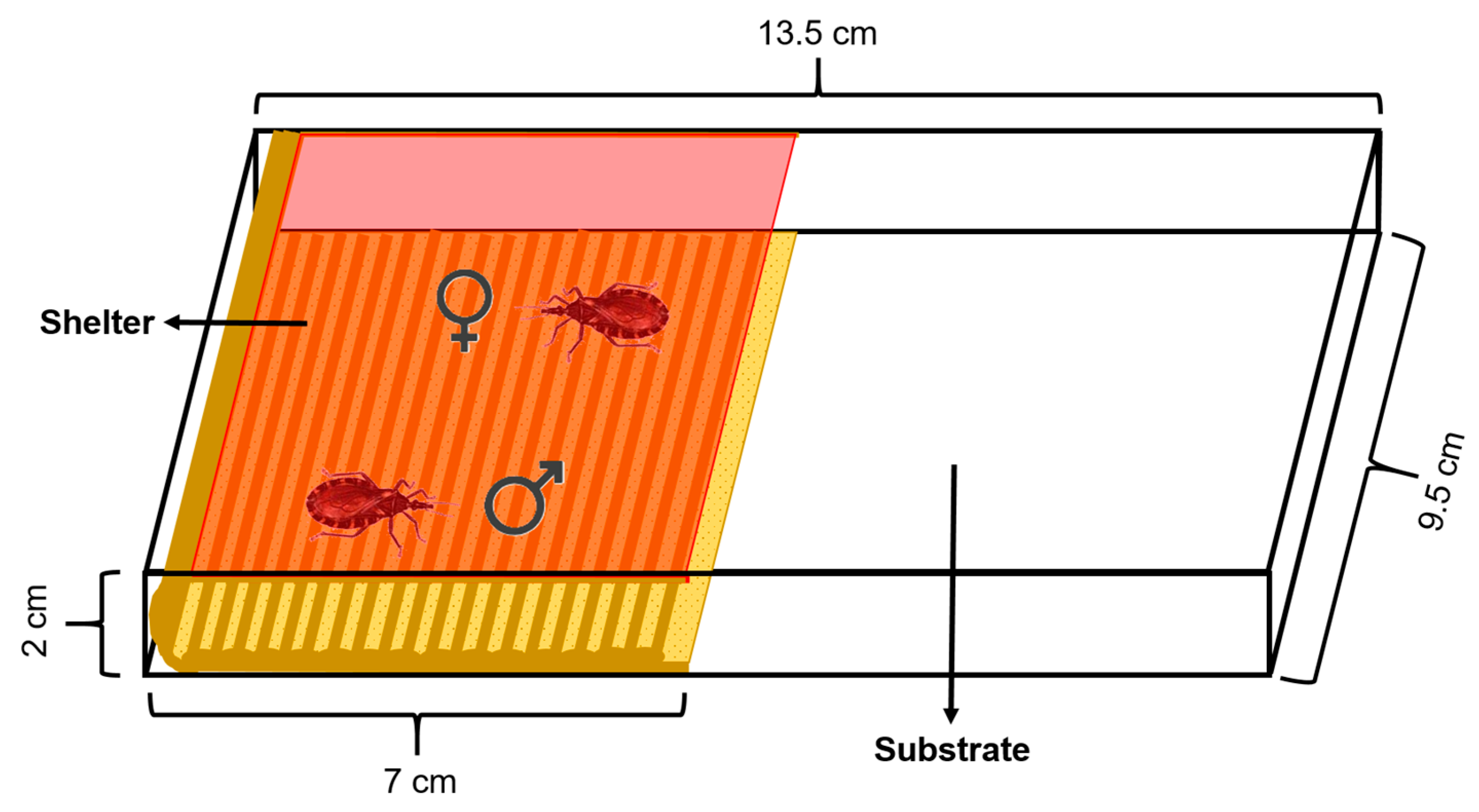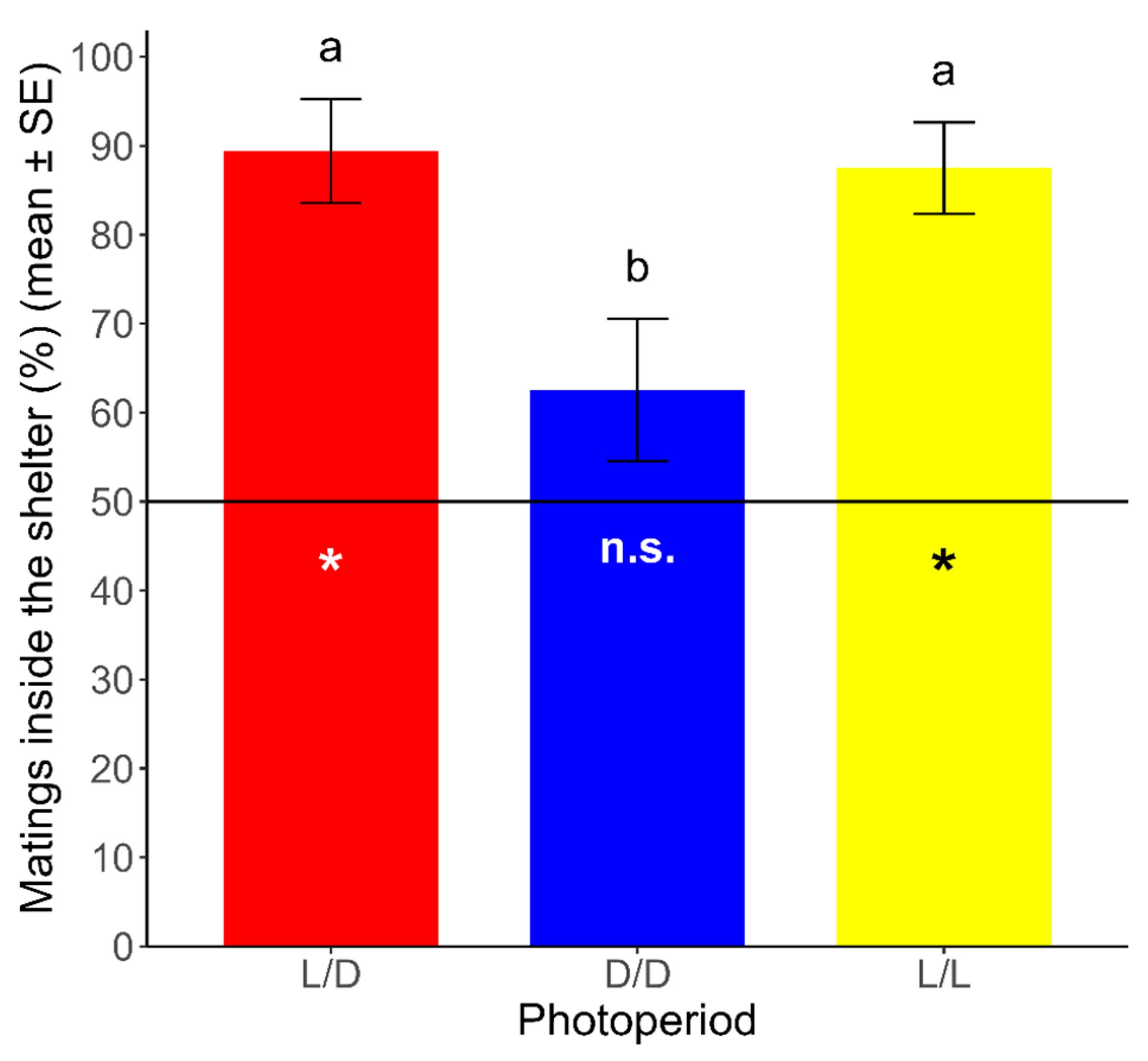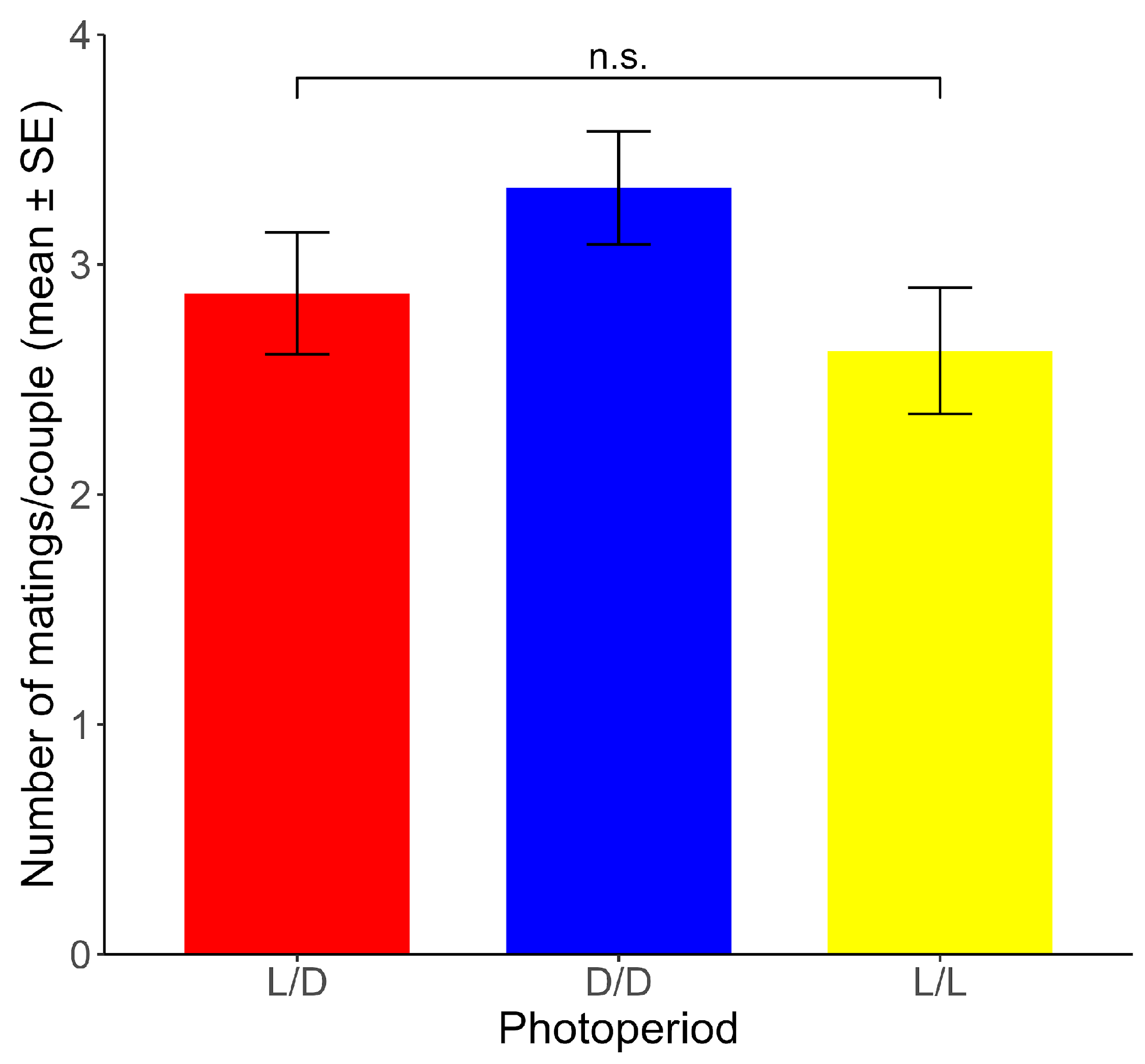Temporal and Spatial Patterns of Mating in Rhodnius prolixus
Simple Summary
Abstract
1. Introduction
2. Materials and Methods
2.1. Insects
2.2. The Experimental Device
2.3. The Procedure
2.4. The Data Analysis
3. Results
3.1. The Temporal Pattern of Mating in R. prolixus
3.2. The Spatial Pattern of Mating in R. prolixus
3.3. The Total Number of Matings and the Distribution of Mating Across Days for Each Photoperiod
4. Discussion
5. Conclusions
Author Contributions
Funding
Data Availability Statement
Acknowledgments
Conflicts of Interest
References
- Vitaterna, M.H.; Takahashi, J.S.; Turek, F.W. Overview of circadian rhythms. Alcohol Res. Health 2001, 25, 85. [Google Scholar]
- Patke, A.; Young, M.W.; Axelrod, S. Molecular mechanisms and physiological importance of circadian rhythms. Nat. Rev. Mol. Cell Biol. 2020, 21, 67–84. [Google Scholar] [CrossRef] [PubMed]
- Aschoff, J. Temporal orientation: Circadian clocks in animals and humans. Anim. Behav. 1989, 37, 881–896. [Google Scholar] [CrossRef]
- Saunders, D.S. Insect Clocks, 1st ed.; Elsevier: Amsterdam, The Netherlands, 2002; pp. 7–42. [Google Scholar]
- Saunders, D.S. Circadian rhythms and the evolution of photoperiodic timing in insects. Physiol. Entomol. 2009, 34, 301–308. [Google Scholar] [CrossRef]
- Bloch, G.; Hazan, E.; Rafaeli, A. Circadian rhythms and endocrine functions in adult insects. J. Insect Physiol. 2013, 59, 56–69. [Google Scholar] [CrossRef] [PubMed]
- Levi-Zada, A.; Byers, J.A. Circadian rhythms of insect pheromone titer, calling, emission, and response: A review. Sci. Nat. 2021, 108, 35. [Google Scholar] [CrossRef]
- Barrozo, R.B.; Schilman, P.E.; Minoli, S.A.; Lazzari, C.R. Daily rhythms in disease-vector insects. Biol. Rhythm Res. 2004, 35, 79–92. [Google Scholar] [CrossRef]
- Alves Meireles-Filho, A.C.; Kyriacou, C.P. Circadian rhythms in insect disease vectors. Mem. Inst. Oswaldo Cruz 2013, 108, 48–58. [Google Scholar] [CrossRef]
- Alevi, K.C.C.; de Oliveira, J.; da Silva Rocha, D.; Galvão, C. Trends in taxonomy of Chagas disease vectors (Hemiptera, Reduviidae, Triatominae): From Linnaean to integrative taxonomy. Pathogens 2021, 10, 1627. [Google Scholar] [CrossRef]
- Lazzari, C.R. Circadian organization of locomotion activity in the haematophagous bug Triatoma infestans. J. Insect Physiol. 1992, 38, 895–903. [Google Scholar] [CrossRef]
- Lorenzo, M.G.; Lazzari, C.R. Activity pattern in relation to refuge exploitation and feeding in Triatoma infestans (Hemiptera: Reduviidae). Acta Trop. 1998, 70, 163–170. [Google Scholar] [CrossRef] [PubMed]
- Pavan, M.G.; Corrêa-Antônio, J.; Peixoto, A.A.; Monteiro, F.A.; Rivas, G.B. Rhodnius prolixus and R. robustus (Hemiptera: Reduviidae) nymphs show different locomotor patterns on an automated recording system. Parasit. Vectors 2016, 9, 239. [Google Scholar] [CrossRef] [PubMed]
- Barrozo, R.B.; Minoli, S.A.; Lazzari, C.R. Circadian rhythm of behavioural responsiveness to carbon dioxide in the blood-sucking bug Triatoma infestans (Heteroptera: Reduviidae). J. Insect Physiol. 2004, 50, 249–254. [Google Scholar] [CrossRef]
- Minoli, S.A.; Baraballe, S.; Lorenzo Figueiras, A.N. Daily rhythm of aggregation in the haematophagous bug Triatoma infestans (Heteroptera: Reduviidae). Mem. Inst. Oswaldo Cruz 2007, 102, 449–454. [Google Scholar] [CrossRef]
- Bodin, A.; Barrozo, R.B.; Couton, L.; Lazzari, C.R. Temporal modulation and adaptive control of the behavioural response to odours in Rhodnius prolixus. J. Insect Physiol. 2008, 54, 1343–1348. [Google Scholar] [CrossRef]
- Reisenman, C.E.; Lazzari, C.R.; Giurfa, M. Circadian control of photonegative sensitivity in the haematophagous bug Triatoma infestans. J. Comp. Physiol. A 1998, 183, 533–541. [Google Scholar] [CrossRef]
- Minoli, S.A.; Lazzari, C.R. Chronobiological basis of thermopreference in the haematophagous bug Triatoma infestans. J. Insect Physiol. 2003, 49, 927–932. [Google Scholar] [CrossRef]
- Schilman, P.E.; Lazzari, C.R. Temperature preference in Rhodnius prolixus, effects and possible consequences. Acta Trop. 2004, 90, 115–122. [Google Scholar] [CrossRef]
- Fresquet, N.; Lazzari, C.R. Daily variation of the response to heat in Rhodnius prolixus: The roles of light and temperature as synchronisers. J. Insect Physiol. 2014, 70, 36–40. [Google Scholar] [CrossRef]
- Walker, W.F. Mating behaviour in Oncopeltus fasciatus: Circadian rhythms of coupling, copulation duration and ‘rocking’ behaviour. Physiol. Entomol. 1979, 4, 275–283. [Google Scholar] [CrossRef]
- Mbata, G.N.; Shu, S.; Ramaswamy, S.B. Rhythmicity of mating and oviposition in Callosobruchus subinnotatus (Pic) (Coleoptera: Bruchidae). J. Insect Behav. 1997, 10, 409–423. [Google Scholar] [CrossRef]
- Rymer, J.; Bauernfeind, A.L.; Brown, S.; Page, T.L. Circadian rhythms in the mating behavior of the cockroach, Leucophaea maderae. J. Biol. Rhythm. 2007, 22, 43–57. [Google Scholar] [CrossRef] [PubMed]
- Liu, X.P.; He, H.M.; Kuang, X.J.; Xue, F.S. Mating behavior of the cabbage beetle, Colaphellus bowringi (Coleoptera: Chrysomelidae). Insect Sci. 2010, 17, 61–66. [Google Scholar] [CrossRef]
- Pompilio, L.; Franco, M.G.; Chisari, L.B.; Manrique, G. Female choosiness and mating opportunities in the blood-sucking bug Rhodnius prolixus. Behaviour 2016, 153, 1863–1878. [Google Scholar] [CrossRef]
- Chiang, R.G.; Chiang, J.A. Reproductive physiology in the blood feeding insect, Rhodnius prolixus, from copulation to the control of egg production. J. Insect Physiol. 2017, 97, 27–37. [Google Scholar] [CrossRef]
- De Simone, G.A.; Pompilio, L.; Manrique, G. The effects of a male audience on male and female mating behaviour in the blood-sucking bug Rhodnius prolixus. Neotrop. Entomol. 2022, 51, 212–220. [Google Scholar] [CrossRef]
- Davey, K. The interaction of feeding and mating in the hormonal control of egg production in Rhodnius prolixus. J. Insect Physiol. 2007, 53, 208–215. [Google Scholar] [CrossRef] [PubMed]
- Lange, A.B.; Leyria, J.; Orchard, I. The hormonal and neural control of egg production in the historically important model insect, Rhodnius prolixus: A review, with new insights in this post-genomic era. Gen. Comp. Endocrinol. 2022, 321, 114030. [Google Scholar] [CrossRef]
- Pontes, G.B.; Bohman, B.; Unelius, C.R.; Lorenzo, M.G. Metasternal gland volatiles and sexual communication in the triatomine bug, Rhodnius prolixus. J. Chem. Ecol. 2008, 34, 450–457. [Google Scholar] [CrossRef]
- Pontes, G.B.; Zacharias, C.A.; Manrique, G.; Lorenzo, M.G. Female odours promote the activation of sheltered kissing bug Rhodnius prolixus males and modulate their orientation. Med. Vet. Entomol. 2014, 28, 257–263. [Google Scholar] [CrossRef]
- Lazzari, C.R.; Pereira, M.H.; Lorenzo, M.G. Behavioural biology of Chagas disease vectors. Mem. Inst. Oswaldo Cruz 2013, 108, 34–47. [Google Scholar] [CrossRef] [PubMed]
- Ferreira, R.A.; Guarneri, A.A.; Lorenzo, M.G. Activity and shelter-related behavior in Rhodnius prolixus: The role of host odours. Acta Trop. 2019, 196, 150–154. [Google Scholar] [CrossRef]
- Mosquera, K.D.; Lorenzo, M.G. Species-specific patterns of shelter exploitation in Chagas disease vectors of the genus Rhodnius. Acta Trop. 2020, 205, 105433. [Google Scholar] [CrossRef]
- Lorenzo, M.G.; Lazzari, C.R. Temperature and relative humidity affect the selection of shelters by Triatoma infestans, vector of Chagas disease. Acta Trop. 1999, 72, 241–249. [Google Scholar] [CrossRef] [PubMed]
- Zacharias, C.A.; Manrique, G.; Minoli, S.A. Shelter selection in the kissing bugs Triatoma infestans and Rhodnius prolixus: Intra- and inter-specific interactions and quality evaluation. Med. Vet. Entomol. 2023, 37, 76–85. [Google Scholar] [CrossRef] [PubMed]
- Zacharias, C.A.; Minoli, S.A.; Manrique, G. Differences in competitive ability for the occupancy of shelters in triatomines. Med. Vet. Entomol. 2017, 31, 252–262. [Google Scholar] [CrossRef]
- Scharf, I. The multifaceted effects of starvation on arthropod behaviour. Anim. Behav. 2016, 119, 37–48. [Google Scholar] [CrossRef]
- Dion, E.; Monteiro, A.; Nieberding, C.M. The role of learning on insect and spider sexual behaviors, sexual trait evolution, and speciation. Front. Ecol. Evol. 2019, 6, 225. [Google Scholar] [CrossRef]
- De Simone, G.A.; Pompilio, L.; Manrique, G. Females of a blood-sucking bug may adjust their mating decisions according to the risk of ovipositing infertile eggs. Ethology 2020, 126, 493–502. [Google Scholar] [CrossRef]
- Barrozo, R.B.; Reisenman, C.E.; Guerenstein, P.; Lazzari, C.R.; Lorenzo, M.G. An inside look at the sensory biology of triatomines. J. Insect Physiol. 2017, 97, 3–19. [Google Scholar] [CrossRef]
- Manrique, G.; Vitta, A.C.; Ferreira, R.A.; Zani, C.L.; Unelius, C.R.; Lazzari, C.R.; Diotaiuti, L.; Lorenzo, M.G. Chemical communication in Chagas disease vectors. Source, identity, and potential function of volatiles released by the metasternal and Brindley’s glands of Triatoma infestans adults. J. Chem. Ecol. 2006, 32, 2035–2052. [Google Scholar] [CrossRef] [PubMed]
- Aschoff, J. Exogenous and endogenous components in circadian rhythms. In Cold Spring Harbor Symposia on Quantitative Biology, Andechs, Germany; Cold Spring Harbor Laboratory Press: New York, NY, USA, 1960; Volume 25, pp. 11–28. [Google Scholar] [CrossRef]
- Witting, W.; Boerma, D.; Koster-Van Hoffen, G.C.; Swaab, D.F.; Mirmiran, M. Light suppresses frequency and endogenous amplitude of the circadian system in nocturnal animals. Biol. Rhythm Res. 1995, 26, 477–485. [Google Scholar] [CrossRef]
- Crespo, J.G.; Manrique, G. Mating behavior of the hematophagous bug Triatoma infestans: Role of Brindley’s and metasternal glands. J. Insect Physiol. 2007, 53, 708–714. [Google Scholar] [CrossRef]
- May-Concha, I.; Rojas, J.C.; Cruz-López, L.; Millar, J.G.; Ramsey, J.M. Volatile compounds emitted by Triatoma dimidiata, a vector of Chagas disease: Chemical analysis and behavioural evaluation. Med. Vet. Entomol. 2013, 27, 165–174. [Google Scholar] [CrossRef]
- Zacharias, C.A.; Pontes, G.B.; Lorenzo, M.G.; Manrique, G. Flight initiation by male Rhodnius prolixus is promoted by female odors. J. Chem. Ecol. 2010, 36, 449–451. [Google Scholar] [CrossRef]
- Pontes, G.B.; Lorenzo, M.G. Female metasternal gland odours mediate male aggregation in Rhodnius prolixus, a triatomid bug. Med. Vet. Entomol. 2012, 26, 33–36. [Google Scholar] [CrossRef]
- Lazzari, C.R. Orientation towards hosts in haematophagous insects: An integrative perspective. Adv. Insect Physiol. 2009, 37, 1–58. [Google Scholar] [CrossRef]
- Reis, M.D.; Miller, D.M. Host searching and aggregation activity of recently fed and unfed bed bugs (Cimex lectularius L.). Insects 2011, 2, 186–194. [Google Scholar] [CrossRef]
- Yuval, B. Mating systems of blood-feeding flies. Annu. Rev. Entomol. 2006, 51, 413–440. [Google Scholar] [CrossRef]
- Baeshen, R. Swarming behavior in Anopheles gambiae (sensu lato): Current knowledge and future outlook. J. Med. Entomol. 2022, 59, 56–66. [Google Scholar] [CrossRef]
- Takken, W.; Charlwood, D.; Lindsay, S.W. The behaviour of adult Anopheles gambiae, sub-Saharan Africa’s principal malaria vector, and its relevance to malaria control: A review. Malar. J. 2024, 23, 161. [Google Scholar] [CrossRef] [PubMed]
- Fritz, M.L.; Walker, E.D.; Yunker, A.J.; Dworkin, I. Daily blood feeding rhythms of laboratory-reared North American Culex pipiens. J. Circadian Rhythms 2014, 12, 1. [Google Scholar] [CrossRef] [PubMed]
- Kim, S.; Trocke, S.; Sim, C. Comparative studies of stenogamous behaviour in the mosquito Culex pipiens complex. Med. Vet. Entomol. 2018, 32, 427–435. [Google Scholar] [CrossRef]
- Hartberg, W.K. Observations on the mating behaviour of Aedes aegypti in nature. Bull. World Health Organ. 1971, 45, 847. [Google Scholar]
- Jones, M.D.R. The programming of circadian flight-activity in relation to mating and the gonotrophic cycle in the mosquito, Aedes aegypti. Physiol. Entomol. 1981, 6, 307–313. [Google Scholar] [CrossRef]
- Triana, M.F.; Melo, N. The dynamics of Aedes aegypti mating behavior. Curr. Opin. Insect Sci. 2024, 65, 101237. [Google Scholar] [CrossRef]
- Rivas, G.B.S.; Souza, N.A.; Peixoto, A.A. Analysis of the activity patterns of two sympatric sandfly siblings of the Lutzomyia longipalpis species complex from Brazil. Med. Vet. Entomol. 2008, 22, 288–290. [Google Scholar] [CrossRef] [PubMed]
- Rivas, G.B.; de Souza, N.A.; Peixoto, A.A.; Bruno, R.V. Effects of temperature and photoperiod on daily activity rhythms of Lutzomyia longipalpis (Diptera: Psychodidae). Parasites Vectors 2014, 7, 278. [Google Scholar] [CrossRef]
- Spiegel, C.N.; Dias, D.B.D.S.; Araki, A.S.; Hamilton, J.G.; Brazil, R.P.; Jones, T.M. The Lutzomyia longipalpis complex: A brief natural history of aggregation-sex pheromone communication. Parasites Vectors 2016, 9, 580. [Google Scholar] [CrossRef]
- Kelly, C.D. Resource quality or harem size: What influences male tenure at refuge sites in tree weta (Orthoptera: Anostostomatidae)? Behav. Ecol. Sociobiol. 2006, 60, 175–183. [Google Scholar] [CrossRef]
- Xu, H.; Turlings, T.C. Plant volatiles as mate-finding cues for insects. Trends Plant Sci. 2018, 23, 100–111. [Google Scholar] [CrossRef] [PubMed]





Disclaimer/Publisher’s Note: The statements, opinions and data contained in all publications are solely those of the individual author(s) and contributor(s) and not of MDPI and/or the editor(s). MDPI and/or the editor(s) disclaim responsibility for any injury to people or property resulting from any ideas, methods, instructions or products referred to in the content. |
© 2025 by the authors. Licensee MDPI, Basel, Switzerland. This article is an open access article distributed under the terms and conditions of the Creative Commons Attribution (CC BY) license (https://creativecommons.org/licenses/by/4.0/).
Share and Cite
Divito, F.; De Simone, G.A.; Pompilio, L.; Manrique, G. Temporal and Spatial Patterns of Mating in Rhodnius prolixus. Insects 2025, 16, 312. https://doi.org/10.3390/insects16030312
Divito F, De Simone GA, Pompilio L, Manrique G. Temporal and Spatial Patterns of Mating in Rhodnius prolixus. Insects. 2025; 16(3):312. https://doi.org/10.3390/insects16030312
Chicago/Turabian StyleDivito, Franco, Gabriel A. De Simone, Lorena Pompilio, and Gabriel Manrique. 2025. "Temporal and Spatial Patterns of Mating in Rhodnius prolixus" Insects 16, no. 3: 312. https://doi.org/10.3390/insects16030312
APA StyleDivito, F., De Simone, G. A., Pompilio, L., & Manrique, G. (2025). Temporal and Spatial Patterns of Mating in Rhodnius prolixus. Insects, 16(3), 312. https://doi.org/10.3390/insects16030312






